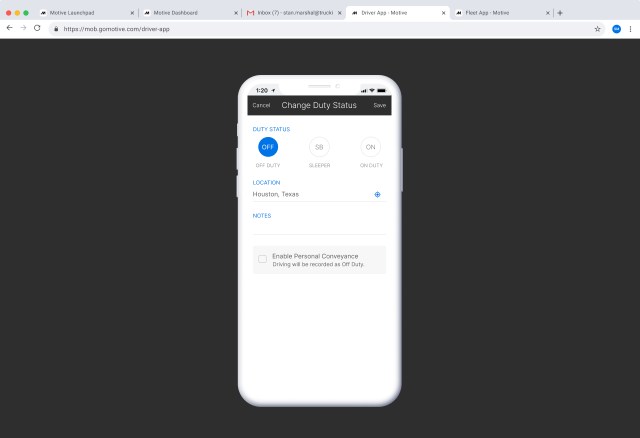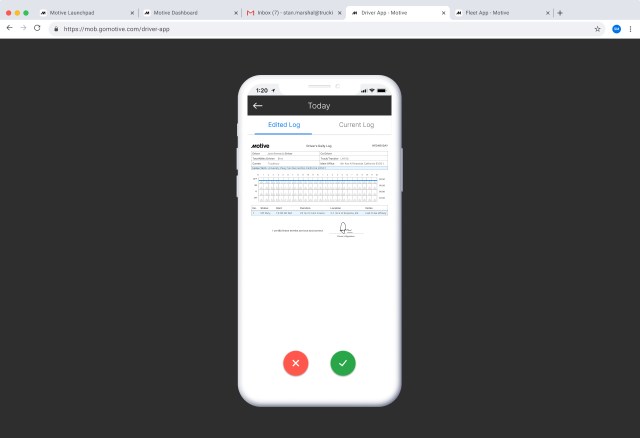Motive is on a mission to build the most powerful and reliable ELD system on the market. The foundation of that mission is full compliance with the 516 pages of requirements in the ELD mandate. After extensive product development and exhaustive testing, we are thrilled to announce that Motive is now FMCSA-registered and listed in the FMCSA’s list of self-certified ELDs.
One of Motive’s core values is transparency — below are the exact steps we’ve taken to ensure that our ELD is fully compliant with DOT regulations. As you evaluate ELD vendors, ask them to prove to you that they can deliver on each one of these features — if they can’t, you won’t be compliant with the ELD mandate.
Unidentified trips
The ELD mandate requires that all vehicle motion is tracked by an engine-connected device. For those times when a driver has not specifically logged into the ELD to associate the vehicle’s operation with their logs, that time must be recorded and attributed to an “unidentified driver”.
Upon logging in or connecting to a vehicle, a driver should be shown the unidentified trips that have been accumulated on that vehicle over the past 24 hours and 7 days. We prominently display this information to drivers, which makes it easy for them to claim their Driving time.
Special driving categories
The FMCSA outlined special driving categories in the ELD rule that allow drivers to keep Driving time off their logs. The ELD still records all vehicle movements above 5 MPH, but these special driving categories — that not all vendors support — let drivers operate the vehicle for Yard Moves (On Duty) and Personal Conveyance (Off Duty).
Our application allows a driver to indicate that an upcoming Driving period should be flagged as a special driving category. These special categories allow drivers to appropriately account for Driving time without altering logs or violating the ELD mandate. Fleet managers can enable drivers’ access to Yard Moves and Personal Conveyance on the Motive Dashboard.

Log edit suggestions
A large portion of the FMCSA’s ELD mandate is dedicated to protecting drivers from potential harassment. One of the key components of these protections is the enforcement of Log Edit Suggestions.
Motive does not allow a fleet manager to freely edit a driver’s logs. Instead, the fleet manager may propose changes to a log, or reassign Driving time, through Log Edit Suggestions. The driver is then given an opportunity to review the fleet manager’s edits, and either accept or reject them. Once the driver accepts the edits, their log is updated accordingly.
Drivers can edit and change their logs freely, without the approval of a fleet manager. However, the mandate requires that Driving time never be adjusted on a log — only changes to notes or location information are allowed.
To further enhance driver protection, we do not allow fleet managers to edit a driver’s log from the current day. This gives drivers an opportunity to complete and certify their logs before a fleet manager can make edit suggestions.

Automatic changes in duty status
The ELD mandate specifically states that the driver’s duty status must automatically change to Driving at a threshold of 5 MPH. Some legacy providers — who mask their AOBRDs as ELDs — do not comply with this ELD rule.
A driver’s duty status can also automatically change from Driving to On Duty. This can happen if the vehicle remains stationary for 6 minutes. For a vehicle to be considered stationary, it must be at 0 MPH for 3 seconds. After 5 minutes of stationary time have passed, we display a prompt to ask the driver if they are still driving. The driver is then given 60 seconds to respond to the prompt. If no action is taken, we automatically change their status to On Duty, beginning from the moment the vehicle stopped moving.
Preventing driver interaction while in motion
Driver and public safety is the reason we have HOS rules. In keeping with this goal, we restrict the driver’s ability to navigate within the Motive Electronic Logbook App while the vehicle is in motion. We have designed an informative, driver-tested, Driving lock screen with daytime and nighttime modes. This lets drivers get key information without being distracted from vehicle operations.

Data transfer methods & ELD output file
The mandate requires that ELDs have a way to transmit data to DOT officers using either “telematic” or “local electronic” data transfer methods. Motive’s ELD solution uses the former, which sends data to DOT officers through their choice of either wireless web services or email.
Included in this portion of the rule, the FMCSA specified a structure for output files that contain ELD data. This “ELD output file” is the format that must be used to transmit structured ELD data to DOT officials. Motive has developed a compliant output file for transfer, but the FMCSA is yet to detail where this data should posted.
As a back up, the ELD must be able to visually display standardized ELD log data to an authorized safety official on demand, with a simple one-step process. With Motive, drivers can easily share their logs with officers by going into DOT Inspection Mode.

ELD requirements and Motive
This just scratches the surface of the 516 pages of requirements included in the ELD mandate. Under the hood are many additional requirements, such as time zone offsets, separated driver and fleet manager accounts, driver data safeguards, intermediate logs, maintaining a full log edit history, RODS certifications, unidentified Driving visual indicators, and a whole lot more.
While there are many choices for ELD compliance, we’ve spent more time focusing on the details than anyone else listed to date. You can be confident in choosing Motive as your partner for ELD mandate compliance and beyond. Learn more about the Motive ELD.



